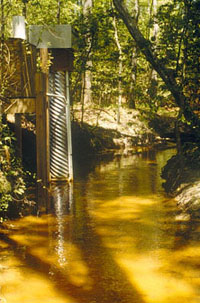
Changes
in streamflow in cubic feet per second (Flow) and light absorbance at 253.7
nanometers (UV254) during a storm-flow period on the Chickahominy River.
|
|
"Tea color" from organic carbon in |
Problem
Certain
organic compounds in natural waters form trihalomethanes (THMs), haloacetic
acids (HAAs), and total halogenated organic compounds (TOXs) when the waters
are disinfected with chlorine or other oxidants for public supplies.
Organic compounds that form these disinfection by products (DBPs) must
be removed when concentrations exceed certain levels because the DBPs are
suspected carcinogenic compounds for which the U.S. Environmental Protection
Agency has established maximum contaminant levels (MCLs) for drinking water.
Humic and fulvic acids (high molecular weight, aromatic, organic
compounds) have been identified as THM precursors and other compounds can
contribute to the formations of other DBPs.
DBP precursors (organic materials that can form DBPs)
are abundant in wetlands environments and the water that discharges from these
environments. Therefore, DBPs are
a concern for public water supplies that use water that has flowed through
wetlands.
Raw water for public supply for the City of Newport News and other localities in
Virginia is provided
by watersheds having extensive wetlands.
The city is evaluating additional watersheds having wetlands as possible
new sources of water. These extensive wetlands
have a variety of vegetation and water
regimes. Knowledge of the effects
that wetland environments, seasons, and hydrology have on concentrations of
dissolved organic carbon (DOC) and DBP precursors in these watersheds can be
used by localities to select times for withdrawing and storing raw
water having low concentrations of DOC and DBP precursors.
Selective withdrawal can help reduce the cost of treatment to remove DBP
precursors. This knowlege can also
help in evaluating watersheds as potential future water sources.
Objective
The
objective of this project was to identify relations of hydrology and seasons to
concentrations of DOC and DBP precursors in waters of watersheds in the Coastal
Plain of Virginia having extensive wetlands, using the Chickahominy River and
Diascund Creek Reservoir Watersheds as examples.
Relevance and Benefits
Results
of this study improve the understanding of the transport of DOC and DBP
precursors through watersheds having extensive wetlands.
This understanding helps localities manage the
withdrawal of water from such rivers in a manner to provide a public
water supply that meets the drinking-water standards for DBPs at a minimum cost. Results will also help
evaluate watersheds as potential water sources.
Approach
This
investigation related the formation potential for THMs, HAAs, and TOXs
(indicators of DBP precursors), the absorbance of UV light at 254 (an indicator of concentrations of aromatic compounds that commonly
form THMs), and DOC concentrations to wetlands environments, seasons, and hydrology during baseflow and stormwater flows at
selected sites in the Chickahominy River and Diascund Creek Reservoir Watersheds. The
amount of DOC and DBP precursors produced by organic detritus in the streams was
evaluated. The contribution of
DOC and BDP precursors to stormwater flow and baseflow through different
hydrologic pathways was also evaluated.

